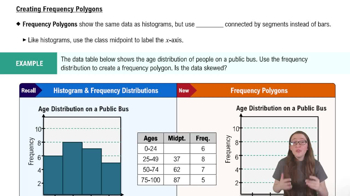For the four test scores 96, 85, 91, and 86, the first 3 test scores are 20% of the final grade, and the last test score is 40% of the final grade. Find the weighted mean of the test scores.
Table of contents
- 1. Intro to Stats and Collecting Data1h 14m
- 2. Describing Data with Tables and Graphs1h 55m
- 3. Describing Data Numerically2h 5m
- 4. Probability2h 16m
- 5. Binomial Distribution & Discrete Random Variables3h 6m
- 6. Normal Distribution and Continuous Random Variables2h 11m
- 7. Sampling Distributions & Confidence Intervals: Mean3h 23m
- Sampling Distribution of the Sample Mean and Central Limit Theorem19m
- Distribution of Sample Mean - Excel23m
- Introduction to Confidence Intervals15m
- Confidence Intervals for Population Mean1h 18m
- Determining the Minimum Sample Size Required12m
- Finding Probabilities and T Critical Values - Excel28m
- Confidence Intervals for Population Means - Excel25m
- 8. Sampling Distributions & Confidence Intervals: Proportion1h 25m
- 9. Hypothesis Testing for One Sample3h 29m
- 10. Hypothesis Testing for Two Samples4h 50m
- Two Proportions1h 13m
- Two Proportions Hypothesis Test - Excel28m
- Two Means - Unknown, Unequal Variance1h 3m
- Two Means - Unknown Variances Hypothesis Test - Excel12m
- Two Means - Unknown, Equal Variance15m
- Two Means - Unknown, Equal Variances Hypothesis Test - Excel9m
- Two Means - Known Variance12m
- Two Means - Sigma Known Hypothesis Test - Excel21m
- Two Means - Matched Pairs (Dependent Samples)42m
- Matched Pairs Hypothesis Test - Excel12m
- 11. Correlation1h 6m
- 12. Regression1h 50m
- 13. Chi-Square Tests & Goodness of Fit1h 57m
- 14. ANOVA1h 57m
3. Describing Data Numerically
Mean
Problem 2.3.50
Textbook Question
Finding the Mean of a Frequency Distribution In Exercises 49–52, approximate the mean of the frequency distribution.
Social Media The average daily amounts of time (in minutes) spent on Snapchat

 Verified step by step guidance
Verified step by step guidance1
Step 1: Identify the midpoints of each class interval. The midpoint is calculated as the average of the lower and upper boundaries of each interval. For example, for the interval 0–19, the midpoint is (0 + 19) / 2 = 9.5.
Step 2: Multiply each midpoint by its corresponding frequency to find the 'frequency × midpoint' product for each class interval. For example, for the interval 0–19, the product is 9.5 × 8 = 76.
Step 3: Sum all the 'frequency × midpoint' products obtained in Step 2. This gives the total of all weighted midpoints.
Step 4: Calculate the total frequency by summing all the frequencies provided in the table. For example, the total frequency is 8 + 8 + 15 + 10 + 7 = 48.
Step 5: Divide the sum of 'frequency × midpoint' products (from Step 3) by the total frequency (from Step 4) to approximate the mean of the frequency distribution. The formula is Mean = (Σ(frequency × midpoint)) / (Σ(frequency)).
 Verified video answer for a similar problem:
Verified video answer for a similar problem:This video solution was recommended by our tutors as helpful for the problem above
Video duration:
3mPlay a video:
Was this helpful?
Key Concepts
Here are the essential concepts you must grasp in order to answer the question correctly.
Mean of a Frequency Distribution
The mean of a frequency distribution is calculated by multiplying each class midpoint by its corresponding frequency, summing these products, and then dividing by the total number of observations. This provides a weighted average that reflects the distribution of data across different intervals.
Recommended video:
Guided course

Intro to Frequency Distributions
Class Midpoint
The class midpoint is the value that lies in the middle of a class interval. It is calculated by averaging the lower and upper boundaries of the interval. For example, for the interval 0-19, the midpoint is (0 + 19) / 2 = 9.5, which is used in calculating the mean.
Recommended video:

Frequency Polygons Example 1
Frequency
Frequency refers to the number of occurrences of a particular value or range of values in a dataset. In the context of a frequency distribution, it indicates how many data points fall within each specified interval, which is essential for calculating measures like the mean.
Recommended video:

Creating Frequency Polygons

 4:52m
4:52mWatch next
Master Calculating the Mean with a bite sized video explanation from Patrick
Start learningRelated Videos
Related Practice
Textbook Question
